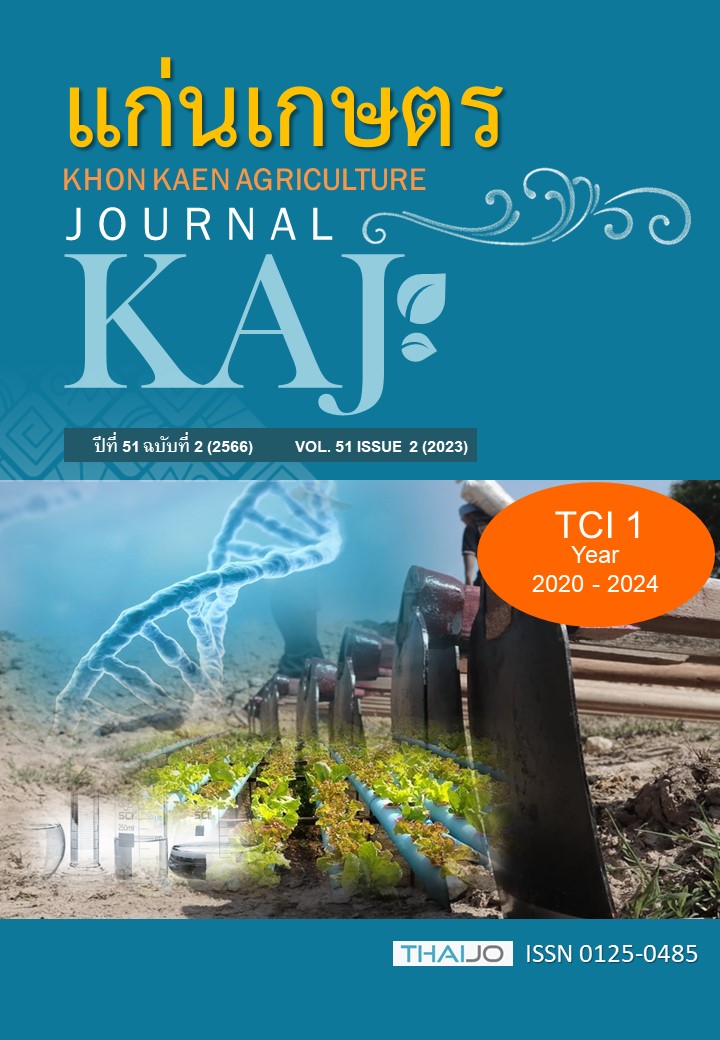ผลของการใส่วัสดุอินทรีย์ปรับปรุงดินต่อปริมาณการแจกกระจายขนาดเม็ดดินในชุดดินยโสธรที่ใช้ปลูกมันสำปะหลัง
Main Article Content
บทคัดย่อ
ศึกษาการแจกกระจายขนาดเม็ดดินในชุดดินยโสธรที่ใช้ปลูกมันสำปะหลังซึ่งมีการใส่วัสดุอินทรีย์ปรับปรุงดินประเภทต่าง ๆ อย่างต่อเนื่องมาเป็นระยะเวลา 7 ปี โดยมีการวางแผนการทดลองแบบ randomized complete block design (RCBD) จำนวน 3 ซ้ำ ประกอบด้วย (1) ไม่ใส่วัสดุอินทรีย์ปรับปรุงดิน (2) ใส่มูลไก่แกลบ อัตรา 1,000 kg/rai (3) ใส่มูลไก่แกลบ อัตรา 2,000 kg/rai (4) ใส่กากแป้งมันสำปะหลัง อัตรา 1,000 kg/rai และ (5) ใส่เปลือกดินมันสำปะหลัง อัตรา 1,000 kg/rai ผลการศึกษาพบว่า การใส่วัสดุอินทรีย์ปรับปรุงดินประเภทต่าง ๆ มีแนวโน้มส่งเสริมให้เกิดการสร้างเม็ดดินขนาด small macroaggregate (SMA: 0.25-2 mm) จากการเชื่อมรวมตัวกันของเม็ดดินขนาด silt and clay size fractions (SiCl: < 0.053 mm) และ microaggregate (MiA: 0.053-0.25 mm) ได้มากกว่าการไม่ใส่วัสดุอินทรีย์ปรับปรุงดิน (ตำรับควบคุม) อย่างมีนัยสำคัญทางสถิติ แต่ยังไม่สามารถส่งเสริมให้เกิดการสร้างเม็ดดินขนาด large macroaggregate (LMA: 2-8 mm) ได้อย่างชัดเจน โดยตำรับการทดลองที่มีการใส่มูลไก่แกลบทั้งสองอัตรามีแนวโน้มส่งเสริมให้เกิดการสะสมคาร์บอนอินทรีย์และไนโตรเจนทั้งหมดในเม็ดดินได้สูงที่สุด อย่างไรก็ตาม ปริมาณคาร์บอนอินทรีย์และไนโตรเจนทั้งหมดในเม็ดดินขนาดต่าง ๆ ของทุกตำรับการทดลองยังมีค่าอยู่ในระดับต่ำมากและส่วนใหญ่เป็นคาร์บอนอินทรีย์ที่อยู่ในรูปที่ย่อยสลายได้ง่าย (labile organic carbon (OC) fraction) มากกว่าคาร์บอนอินทรีย์ในรูปที่เสถียร (stable OC fraction) ดินจึงเกิดการสูญเสียอินทรียวัตถุได้ง่ายเมื่อถูกรบกวนโครงสร้างและส่งผลให้ปริมาณอินทรียวัตถุลดต่ำลงอย่างรวดเร็วหากขาดการจัดการเพิ่มเติมอินทรียวัตถุอย่างต่อเนื่องและสม่ำเสมอ
Article Details

อนุญาตภายใต้เงื่อนไข Creative Commons Attribution-NonCommercial-NoDerivatives 4.0 International License.
เอกสารอ้างอิง
กรมพัฒนาที่ดิน. 2550. สถานภาพทรัพยากรดินและที่ดินของประเทศไทย. สำนักวิจัยพัฒนาการจัดการที่ดิน กระทรวงเกษตรและสหกรณ์, กรุงเทพฯ.
คณาจารย์ภาควิชาปฐพีวิทยา. 2548. ปฐพีวิทยาเบื้องต้น. พิมพ์ครั้งที่ 10. สำนักพิมพ์มหาวิทยาลัยเกษตรศาสตร์, กรุงเทพฯ.
ปิยะ ดวงพัตรา, วิจารณ์ วิชชุกิจ, เจริญศักดิ์ โรจนฤทธิ์พิเชษฐ์, ปิยะวุฒิ พูลสงวน, จำลอง เจียมจำนรรจา, เอ็จ สโรบล และวัชรี เลิศมงคล. 2542. ดินและปุ๋ยมันสำปะหลัง. เอกสารเผยแพร่ทางวิชาการ ฉบับที่ 2. ภาควิชาพืชไร่นา คณะเกษตร มหาวิทยาลัยเกษตรศาสตร์, กรุงเทพฯ.
สุกัญญา จัตตุพรพงษ์ และวราพันธุ์ จินตณวิชญ์. 2552. การใช้ประโยชน์เศษเหลือจากมันสำปะหลัง. ศูนย์ค้นคว้าและพัฒนาวิชาการอาหารสัตว์ สถาบันสุวรรณวาจกกสิกิจฯ, มหาวิทยาลัยเกษตรศาสตร์ วิทยาเขตกำแพงแสน.
สำนักงานเศรษฐกิจการเกษตร. 2563. ข้อมูลเศรษฐกิจการเกษตร. แหล่งข้อมูล: https://www.oae.go.th/view/1/%E0%B8%82%E0%B9%89%E0%B8%AD%E0%B8%A1%E0%B8%B9%E0%B8%A5%E0%B9%80%E0%B8%A8%E0%B8%A3%E0%B8%A9%E0%B8%90%E0%B8%81%E0%B8%B4%E0%B8%88%E0%B8%81%E0%B8%B2%E0%B8%A3%E0%B9%80%E0%B8%81%E0%B8%A9%E0%B8%95%E0%B8%A3/TH-TH. ค้นเมื่อ 20 มีนาคม 2565.
Baes, A.U., and P.R. Bloom. 1989. Diffuse reflectance and transmission Fourier infrared spectroscopy of humic and fulvic acids. Soil Science Society of America Journal. 53: 695–700.
Baldock, J.A., J.M. Oades, A.G. Waters, X. Peng, A.M. Vassallo, and M.A. Wilson. 1992. Aspects of chemical structure of soil organic materials as revealed by solid-state 13C NMR spectroscopy. Biogeochemistry 16: 1-42.
Baldock, J.A., and P.N. Nelson. 2000. Soil organic matter. P. B25–B84. In: M.E. Sumner. Handbook of Soil Science. CRC Press, Boca Raton, FL.
Christensen, B.T. 1992. Physical fractionation of soil and organic matter in primary particle size and density separates. Advances in Soil Science. 20: 1-90.
Christensen, B.T. 2001. Physical fractionation of soil and structural and functional complexity in organic matter turnover. European Journal of Soil Science. 52: 345-353.
Elliott, E., C. Palm, D. Reuss, and C. Monz. 1991. Organic matter contained in soil aggregates from a tropical chronosequence: correction for sand and light fraction. Agriculture, Ecosystems and Environment. 34 (1): 443–451.
Golchin, A., J.M. Oades, J.O. Skjemstad, and P. Clarke. 1994. Soil structure and carbon cycling. Australian Journal of Soil Research. 32: 1043–1068.
Haynes, R.J. 2005. Labile organic matter fractions as central components of the quality of agricultural soils: an overview. Advances in Agronomy. 85: 221–268.
Helfrich, M., H. Flessa, R. Mikutta, A. Dreves, and B. Ludwig. 2007. Comparison of chemical fractionation methods for isolating stable soil organic carbon pools. European Journal of Soil Science. 58 (6): 1316–1329.
Jastrow, J.D., T.W. Boutton, and R.M. Miller. 1996. Carbon dynamics if aggregate-associated organic matter estimated by carbon-13 natural abundance. Soil Science Society of America Journal. 49:25-28.
Kong, A.Y.Y., J. Six, D.C. Bryant, R.F. Denison, and C. van Kessel. 2005. The relationship between carbon input aggregation, and soil organic carbon stabilization in sustainable cropping systems. Soil Science Society of America Journal. 69: 1078–1085.
Mikha, M.M., and C.W. Rice. 2004. Tillage and manure effects on soil and aggregate-associated carbon and nitrogen. Soil Science Society of America Journal. 68: 809–816.
National Soil Survey Center. 1996. Soil Survey Laboratory Methods Manual. Soil Survey Invest Report No. 42, Version 3.0 U.S. Dept Of Agr., U.S. Government Printing Office, Washington D.C.
Nelson, D.W., and L.E. Sommers. 1996. Total carbon, and organic matter. P.961-1010. In: D.L. Sparks, A.L. Page, P.A. Helmke, and R.H. Loeppert. Methods of Soil Analysis. Part III. Chemical Method. Amer. Soc. Agron. Inc., Madison, Wisconsin, USA.
Niemeyer, J., Y. Chen, and J.M. Bollag. 1992. Characterization of humic acids, composts, and peat by diffuse reflectance Fourier-transform infrared spectroscopy. Soil Science Society of America Journal. 56: 135–140.
Oades, J.M., and A.G. Waters. 1991. Aggregate hierarchy in soils. Australian Journal of Soil Research. 29: 815–828.
Poirier, N., S.P. Sohi, J.L. Gaunt, N. Mahieu, E.W. Randall, D.S. Powlson, and R.P. Evershed. 2005. The chemical composition of measurable soil organic matter pools. Organic Geochemistry. 36: 1174–1189.
Puget, P., C. Chenu, and J. Balesdent. 1995. Total and young organic matter distributions in aggregates of silty cultivated soils. European Journal of Soil Science. 46: 449–459.
Six, J., H. Bossuyt, S. Degryze, and K. Denef. 2004. A history of research on the link between (micro)aggregates, soil biota, and soil organic matter dynamics. Soil and Tillage Research. 79(1): 7–31.
Six, J., K. Paustian, E.T. Elliott, and C. Combrink. 2000. Soil structure and organic matter: I. Distribution of aggregate-size classes and aggregate-associated carbon. Soil Science Society of America Journal. 64: 681-689.
Sollins, P., P. Homann, and B.A. Caldwell. 1996. Stabilization and destabilization of soil organic matter: mechanisms and controls. Geoderma. 74: 65–105.
Stevenson, F.J. 1994. Humus Chemistry: Genesis, Composition, Reactions. 2nd edition. John Wiley and Sons, New York.
Strosser, E. 2010. Methods for determination of labile soil organic matter: an overview. Journal of Agrobiology. 27 (2): 49–60.
Tisdall, J.M., and J.M. Oades. 1982. Organic matter and water-stable aggregates in soils. European Journal of Soil Science. 33: 141–163.
Zech, W., N. Senesi, G. Guggenberger, K. Kaiser, J. Lehmann, T.M. Miano, A. Miltner, and G. Schroth. 1997. Factors controlling humification and mineralization of soil organic matter in the tropics. Geoderma. 79: 117−161.


